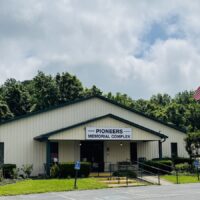In the nearly 6 months since the December tornado outbreak, millions of dollars have been given out to local governments, communities, schools, churches and people to help offset the cost of disaster recovery. Four times so far this month, some of those funds have come from the state under Senate Bill 150.
This Kentucky Senate bill created the State Aid Funding for Emergencies fund, which allows the state to give money to some groups who need funding to offset the costs of recovery. The bill adds to the work of House Bill 5, which set aside state funding to go to schools that needed repairs due to the tornado and funding to buy 200 travel trailers for Kentuckians in need to use as medium-term housing. Between the two bills, $200 million were allotted for tornado recovery.
The big sponsors and supporters of these bills were House District 2 Representative Richard Heath, District 1 Senator Jason Howell and District 4 Senator Robby Mills.
Who qualifies for these funds?
These funds aren’t open to just anyone. In fact, individuals can’t receive these funds. This funding is available to local governments, nonprofit or public utilities groups, state agencies or school districts.
“The entire bill was designed for city and county government and nonprofits, like for example, Mayfield Electric and Water Systems in Mayfield,” Heath said. “It was to keep our county and city governments from going bankrupt as a result of the damage they received in the tornado.”
The funding can offset costs for things like debris cleanup, rebuilding damaged and destroyed buildings and other issues caused by lost tax revenue due to displaced community members. Some of these costs, specifically the cost for debris cleanup, will be reimbursed by the Federal Emergency Management Agency at a later date.
“We set aside $200 million to try to be a bridge for these communities, between paying contractors and debris haulers and all the necessary things that have to be done,” Mills said. “Being a bridge from getting stuff done for the community, to actually getting reimbursed by FEMA, there’s just a long drawn out bureaucratic process for these communities to get paid back.”
Who all has received these funds so far?
Gov. Andy Beshear’s office has announced the awarding of SAFE funds four times so far:
- Hopkins County received $8.5 million of the $155 million dollars available at the end of April.
- The Governor announced $2.8 million to the City of Mayfield and $2 million to Mayfield Electric and Water Systems at the beginning of May. With that same announcement, Caldwell County Fiscal Court received $200,000, the City of Dawson Springs received $122,000, Marshall County Fiscal Court received $811,000, the City of Bowling Green received $44,000 and Hickman County Fiscal Court received $17,000 — totalling that set of funds given out to around $6.1 million dollars.
- The next announcement included more than $3 million dollars going to over 12 different affected groups.
- The latest announcement shared that more than a half a million dollars in SAFE Funds going to Caldwell, Marshall and Lyon County Fiscal Courts.
Mills said this method seemed like a sensible way to distribute aid to impacted communities.
“We wanted to react in a responsible way that wasn’t just throwing money out, but in a responsible way that would help these organizations, whether school systems or cities or counties, or how they can get what they need to get done, quickly, efficiently,” Mills said. “They can get back to normal and not have to worry about a large dollar figure that was keeping them from getting back to normal because they were waiting for federal relief.”
Howell saw it as key to give these tornado-struck locales cash on hand to deal with disaster recovery.
“It is essential and way past due to help our municipalities with cash flow,” Howell said. “Our municipal budgets are set up on a 12 month cycle of revenues and expenditures, kind of like any business would be, and all of their budgets were skewed with all the additional cleanup costs that they incurred from the tornado.”
How much of this money is left?
When the process started with HB5, there was $200 million set aside for disaster recovery. Out of that, there was $30 million earmarked to help school districts with a variety of costs in the initial aftermath and $15 million to buy travel trailers for families in need of housing.
With those funds removed, there was $155 million left to go to the governments and groups that needed the funding assistance. After the most recent announcements, there’s about $135 million left to be given out.
“Had it not been for this money, I think we would see some county and city government and local municipalities going out of business or declaring bankruptcy because they are underinsured,” Heath said. “If you have a farm in one building and lose one building, that’s one thing. But to have a tornado come through and completely destroy the courthouse, the city hall, fire station, take out a water tower – just do millions and millions of dollars of damage to infrastructure – it’s hard to insure adequate for all of that. This is designed as a safety net to keep local government in business and get them back up and operating.”
The application and distribution of these funds is mostly being handled by the Kentucky Emergency Management.
What are the other big things people need to know?
If these groups get funding to offset some of these same costs, they have to pay the state back. But, if alternative funding isn’t secured, they don’t.
“It’s meant to be, like I said, a bridge. Not necessarily a bailout,” Mills said. “But it’s helping them get to reimbursements that the federal government had promised and had in place.”
Additionally, part of this bill is allotted to back up banks offering business loans to damaged businesses. Howell said that while FEMA and insurance are more focused on homes, a new home isn’t going to do any good if people don’t have a place to work. He talked with the Kentucky Bankers Association about what could make this funding good for businesses.
“The end result was the groups agreeing to a million dollar loan pool for businesses, and part of that was, there’s a $25 million backstop of money allocated in Senate Bill 150 to help cover some loss on some loans if they go bad,” Howell said.
This backstop gives the banks some room to work with business in the face of difficulties caused by this storm.
Lily Burris is a features reporter for WKMS. She has a bachelor's degree in journalism from Western Kentucky University. She has written for the College Heights Herald at WKU, interned with Louisville Public Media, served as a tornado recovery reporter with WKMS and most recently worked as a journalist with the Kentucky Center for Investigative Reporting. In her free time, she enjoys reading, crocheting and baking.





